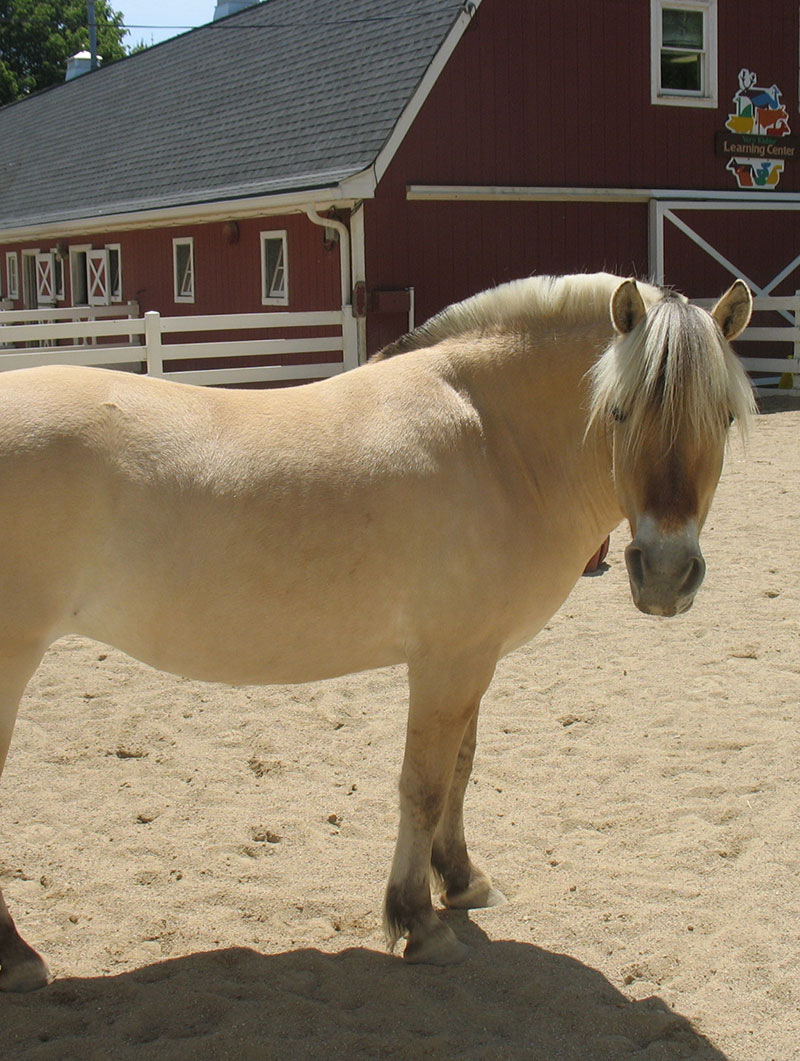Norwegian Fjord
Equus caballus
Description:
A Norwegian fjord is a small but strong breed of horse. Ninety percent of Norwegian Fjords are brown dun in color. “Dun” refers to an animal that has dilute coloration with a darker line down the center of the back and faint zebra-like striping on the legs. The other ten percent of Norwegian fjords also have the dun markings but a different base color. This breed also has a distinctly colored mane, with light-colored hair on the edges and darker hair in the center. The mane is typically cut short, with the outside hair cut slightly shorter, so that it will stand up straight and the coloration can be seen.
Size:
An adult Norwegian fjord measures 13-14 hands (52-56 inches or 132.1-142.2 cm) tall at the withers (shoulders) and weighs between 900 and 1,200 pounds (408.2-544.3 kg).
Adaptations:
As prey animals, horses have many features that help to protect them.
- Their large eyes are set on the side of their heads so they can see nearly all the way around their bodies.
- Their ears swivel separately so they can determine the exact location of a sound.
- Horses’ strong legs enable them to run very quickly to escape predators.
Other adaptations specific to the Norwegian fjord breed are their muscular bodies that historically have allowed them to pull loads and perform other work on farms, and their agility which helped them to navigate Norway’s rocky hillsides.
Diet:
The horses at Cosley Zoo are fed hay, a type of grass grown specifically for animal consumption.
Reproduction:
Horses have an 11-month gestation period, after which they give birth to one foal (baby horse). Twins are rare and undesirable due to their weakness and smaller size.
Shelter and space needs:
Although they can tolerate cold weather fairly well, horses do need shelter from the wind and rain. During the day, the Norwegian fjord shares an outdoor yard with Cosley Zoo’s Shetland pony. Each evening the horses are led into their individual stalls inside the barn to spend the night. They are brought indoors during the day in the case of extreme weather conditions such as heavy rain or lightning.
Life expectancy:
Horses can live to be up to 30 years old, with an average life expectancy of 20-25 years.
Relationship with man:
Traditionally, Norwegian fjords performed work on Norwegian farms. They have a reputation for their calm and gentle temperament, and for being easy to train. They make good family horses and can be ridden or driven.
Fun Facts:
- The height of a horse is measured in hands. Originally a “hand” was equal to the width of a human hand, but the measurement has since been standardized and one hand is now equal to four inches.
- A healthy foal can stand up within one hour of being born.
- Not all horses wear shoes! Shoes are only necessary to protect the feet of horses that often walk on hard surfaces. Cosley Zoo’s horses do not wear shoes, but they do have their hooves trimmed several times a year by a farrier.
- The Norwegian fjord is one of the world’s oldest and purest breeds of horse. The original Norwegian fjord is thought to have been domesticated over 4,000 years ago. All Norwegian fjords are very similar to each other in appearance due to strict breeding standards.
- Norwegian fjords appear in the coats of arms of many Norwegian families, demonstrating this breed’s important role in the country’s history.






